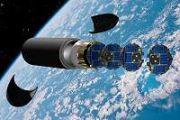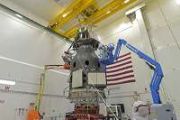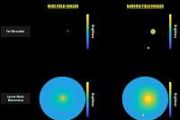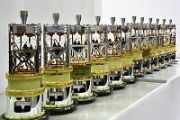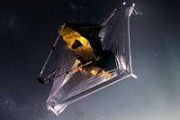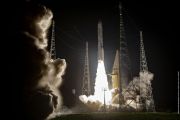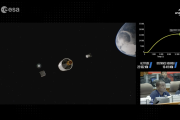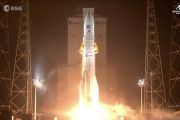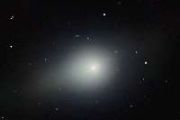
Copernical Team
Garnet Presence in the Deep Lunar Mantle Confirmed
 The current understanding of the Moon's interior reveals a central metallic core, a mantle rich in minerals like olivine and pyroxene, and an outer crust layer. This model has been developed through analyses of lunar samples and seismic data from past Moon missions. Despite extensive studies, the debate about the presence of garnet in the deeper lunar mantle remains unresolved. A critical questi
The current understanding of the Moon's interior reveals a central metallic core, a mantle rich in minerals like olivine and pyroxene, and an outer crust layer. This model has been developed through analyses of lunar samples and seismic data from past Moon missions. Despite extensive studies, the debate about the presence of garnet in the deeper lunar mantle remains unresolved. A critical questi Europe's Earth Return Orbiter Advances to Next Development Stage
 ESA's Earth Return Orbiter (ERO), the pioneering spacecraft designed to capture and return samples from Mars, has achieved a significant milestone, completing its critical design review (CDR). This essential phase confirms the performance, quality, and reliability of the spacecraft's systems, enabling the next steps in its development.
A CDR is a crucial stage in any spaceflight project, e
ESA's Earth Return Orbiter (ERO), the pioneering spacecraft designed to capture and return samples from Mars, has achieved a significant milestone, completing its critical design review (CDR). This essential phase confirms the performance, quality, and reliability of the spacecraft's systems, enabling the next steps in its development.
A CDR is a crucial stage in any spaceflight project, e Lunar Impact Flux Insights
 Scholars have revisited the anchor points and historical construction of lunar crater chronology. Initially, the stratification of the Moon's near side relied on remote sensing data from ground-based telescopes and lunar orbiters before lunar samples were returned. As illustrated in Fig. 1, six manned missions and four robotic missions have brought back various samples, including basalts and vol
Scholars have revisited the anchor points and historical construction of lunar crater chronology. Initially, the stratification of the Moon's near side relied on remote sensing data from ground-based telescopes and lunar orbiters before lunar samples were returned. As illustrated in Fig. 1, six manned missions and four robotic missions have brought back various samples, including basalts and vol 'Ready to come out?' Scientists reemerge after year 'on Mars'
 The NASA astronaut knocks loudly three times on a what appears to be a nondescript door, and calls cheerfully: "You ready to come out?"
The reply is inaudible, but beneath his mask he appears to be grinning as he yanks the door open - and four scientists who have spent a year away from all other human contact, simulating a mission to Mars, spill out to cheers and applause.
Anca Selariu,
The NASA astronaut knocks loudly three times on a what appears to be a nondescript door, and calls cheerfully: "You ready to come out?"
The reply is inaudible, but beneath his mask he appears to be grinning as he yanks the door open - and four scientists who have spent a year away from all other human contact, simulating a mission to Mars, spill out to cheers and applause.
Anca Selariu, SpaceX Secures NASA Contract for COSI Space Telescope Launch
 "NASA has selected Space Exploration Technologies Corporation (SpaceX) of Hawthorne, California, to provide launch services for the COSI (Compton Spectrometer and Imager) mission."
The firm-fixed-price contract is valued at approximately $69 million and includes launch services and associated mission costs. The COSI mission is scheduled to launch in August 2027 aboard a SpaceX Falcon 9 roc
"NASA has selected Space Exploration Technologies Corporation (SpaceX) of Hawthorne, California, to provide launch services for the COSI (Compton Spectrometer and Imager) mission."
The firm-fixed-price contract is valued at approximately $69 million and includes launch services and associated mission costs. The COSI mission is scheduled to launch in August 2027 aboard a SpaceX Falcon 9 roc ESA Council decisions set the stage for more diverse European launch services

LiveEO raises $25M for AI-powered satellite data for infrastructure and risk management
 LiveEO a global leader using high-resolution satellite data and AI to transform raw satellite data into automated actionable insights to help companies manage their climate risks and resilience has raised 25 million in a Series B funding round led by NordicNinja and DeepTech and Climate Fonds (DTCF). This investment will accelerate the development of LiveEO's cutting-edge solutions, and expand i
LiveEO a global leader using high-resolution satellite data and AI to transform raw satellite data into automated actionable insights to help companies manage their climate risks and resilience has raised 25 million in a Series B funding round led by NordicNinja and DeepTech and Climate Fonds (DTCF). This investment will accelerate the development of LiveEO's cutting-edge solutions, and expand i China's Fengyun-3F satellite begins operational services
 The Fengyun-3F (FY-3F) satellite officially commenced operational services on Monday following ground and application system in-orbit testing reviews and operational trial runs, according to its ground application system operator, China Meteorological Administration (CMA).
The FY-3F satellite will take over the in-orbit duties of the FY-3C satellite and provide services in areas such as we
The Fengyun-3F (FY-3F) satellite officially commenced operational services on Monday following ground and application system in-orbit testing reviews and operational trial runs, according to its ground application system operator, China Meteorological Administration (CMA).
The FY-3F satellite will take over the in-orbit duties of the FY-3C satellite and provide services in areas such as we MIT scientists develop way to toughen up 'good' bacteria, extend shelf life
 Massachusetts Institute for Technology officials said Friday its researchers have developed a way to enable microbes used in medicines and agriculture to survive extreme conditions, including the rigors of processing them into tablets with extended shelf-life.
The technique pioneered in the lab of Giovanni Traverso, an associate professor of mechanical engineering, utilizes a range of f
Massachusetts Institute for Technology officials said Friday its researchers have developed a way to enable microbes used in medicines and agriculture to survive extreme conditions, including the rigors of processing them into tablets with extended shelf-life.
The technique pioneered in the lab of Giovanni Traverso, an associate professor of mechanical engineering, utilizes a range of f Gilat to support critical connectivity requirements for the US DOD
 Gilat Satellite Networks Ltd. (NASDAQ, TASE: GILT) has announced that Gilats wholly owned US-based subsidiary, DataPath Inc, received over $9 million in orders in support of the US Department of Defense and other agencies worldwide participating in Field Service and Technical Service Programs.
DataPath is deploying technical services and field services in Europe, the Middle East, and the U
Gilat Satellite Networks Ltd. (NASDAQ, TASE: GILT) has announced that Gilats wholly owned US-based subsidiary, DataPath Inc, received over $9 million in orders in support of the US Department of Defense and other agencies worldwide participating in Field Service and Technical Service Programs.
DataPath is deploying technical services and field services in Europe, the Middle East, and the U 

